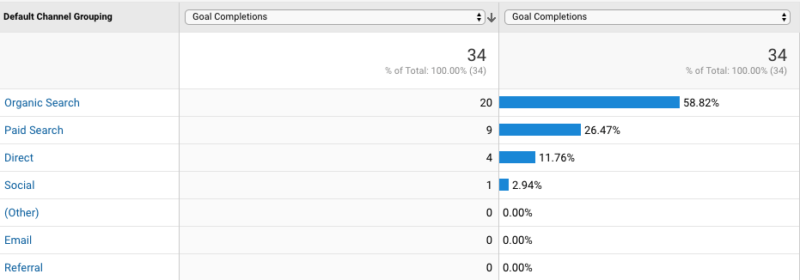
After my agency completely overhauled a small manufacturer’s website, the owner of the company emailed to ask:
“I know a lot has changed recently regarding keywords and search engine optimization, so how do we improve our website results? How do we get the most out of Google Analytics?”
These are great questions – but they need to be phrased a little differently.
Why?
Because getting business results from your website has to do with much more than simply “keywords” or “SEO.”
Some of the questions a small manufacturer need to ask are:
- “By how much do we want to grow our business and how quickly?”
- “How many inquiries, and by extension, closed sales, do we need each month in order to reach this goal?”
- “How do we get these inquiries?”
- “How will we track our results?”
In this article, we’ll address the questions and issues regarding inquiries and tracking results.
Determine the number of inquiries you need
When small manufacturers call to talk about completely redoing their websites, one of the first questions we ask is, “How many inquiries are you getting each month right now?”
The answer is usually “none,” or “few.”
When asked how many they’d like to have, most owners don’t really know. “Mmmmmm . . . maybe five?” is an answer I’ve heard more than once.
One business owner said, “One. We need one inquiry a month because when that inquiry becomes a sale, we’re golden. That sale can mean ongoing work for months or years.”
“But what if that inquiry doesn’t become a sale?” we asked.
Response: {crickets}
Instead of pulling numbers out of thin air, it pays to sit down and analyze your inquiries over the past 12 – 24 months. Some of the questions you and your team need to ask include:
- How many inquiries did we receive for the period?
- How many were targeted or relevant?
- How many went to quote stage – and how long did it take to get to quote stage from the initial call?
- How many became sales – and what was the average dollar amount?
- How long did it take to go from quote stage to closed sale?
- How did these prospects hear about you?
By analyzing your data, you learn the percentage of inquiries that become sales.
For example, if you received 60 inquiries for a 12 month period, and 11 of them became sales that works out to an average of five inquiries a month, with an average of one inquiry per month becoming a sale. Thus, your percentage of inquiries to sales is 18.3%.
If you want to increase the percentage of inquiries to closed sales, then you need to increase the number of inquiries and/or improve your sales process.
For the purpose of this article, we’ll focus on the number of inquiries.
To go from averaging one closed sale a month to averaging three closed sales per month (or 36 for the year), you would need to increase your inquiries to an average of 15 a month or 180 for the year.
How will you get these inquiries?
During our interview process with prospects, we always ask, “How do people hear about you?”
We’ll even ask owners or the Vice Presidents of Business Development to walk us through two or three big sales so we get an idea of the sales process and sales cycle.
No matter the industry or the company, we generally hear the same answer: “Word of mouth.” Sometimes we hear “tradeshows,” but rarely do we hear, “Our website.”
Getting back to our customer and his original question, “How do we improve our website results?” which really means more inquiries — the answer is, “Find ways to drive people back to your website.”
(We’re assuming that you have a modern and updated website that actually helps you get inquiries versus one that’s working against you.)
So, to get those 180 inquiries for the year, you’ll need to create a strategy for helping prospects find your website. Let’s start with Adwords and paid search.
Using AdWords and paid search
Yep, we know it costs money, but we continue to be amazed by the quality of inquiries paid search provides.
Depending on the industry, a well-run, actively managed small campaign (e.g. less than $2,000/month) can deliver anywhere from five to 10+ really good inquiries each month.
Here are three months of conversion data (form completions), plus phone calls, for a small industrial campaign.

Content marketing, organic, and image search
The other thing we love about paid search is that it gives us search query data, which we then use to create website content such as:
- New or revised Product / Services pages
- FAQs
- Tech Tips
- Application Notes / Case Studies
- Charts / Diagrams
- New or revised Product / Services pages
You can then use this content in your e-newsletter and social media efforts. More importantly, you can use query data to better optimize your website including all the new content you’re creating.
Optimized content gets found via organic search which can lead to more inquiries and organic goal completions as you can see here:

In addition to the standard title, description tag and content optimization, you can also optimize your website’s images for Google Image Search which may provide additional rankings and exposure.
Monthly e-newsletters rock!
Yes! Monthly e-newsletters still work. One reason we find them so valuable for manufacturers of custom capabilities is that a well-done monthly e-newsletter keeps your company top of mind with customers and prospects until they’re ready to order.
To improve open rates, have some fun with your e-newsletter! Try to avoid being stodgy or “industrial.”
Here’s an example of a fun way to let newsletter readers know you have a new machine! Instead of doing the standard, “Look, we have a new machine” update, jazz it up with a “Christmas came early” message and include a fun image with a twist:

This email campaign got a lot of chuckles and a number of people emailed the sender back which allowed them to reconnect and start talking business again.
Tradeshows, print advertising and direct mail
Depending on your budget and your audience, other ways to generate inquiries and longer-term leads include tradeshows and trade publication print advertising.
In addition to tradeshow inquiries and floor sales, one of our clients tracks traffic to the website from the ads he runs in associated publications.
And don’t forget about direct mail, it is still an option. Just because few people use it these days doesn’t mean it’s dead.
How to track results
This last segment gets to the heart of the question: “How can we get the most out of Google Analytics?”
Analytics gives you a wealth of information, and in our opinion, so much information that small business owners, who already spend their days putting out fires, don’t have time to absorb it all.
Instead of going down data rabbit holes, it pays to focus on a few key KPIs:
- How many inquiries come from paid, organic and email (Figure 2)?
- How are people contacting you, are they using RFQ, email or phone? You can track phone calls through Click to Call and AdWords dynamic phone tracking.
- If they’re contacting you by phone, are they getting through or hanging up (meaning, is your voice mail system a help or hindrance)?
- Which pieces of content are paying off and why?
In conclusion
Improving your website results begins with asking what results you want to achieve and why.
Instead of pulling numbers of out thin air, analyze past years data to arrive at realistic goals that make sense for your company and the resources you have at hand.
Then, create a marketing plan and consistently work on it. Measure your progress monthly or quarterly – and make changes as needed. You will see results over time.
The post Getting results from your website means asking the right questions appeared first on Search Engine Land.
from SEO Rank Video Blog http://ift.tt/2Gk0jk6
via IFTTT
No comments:
Post a Comment